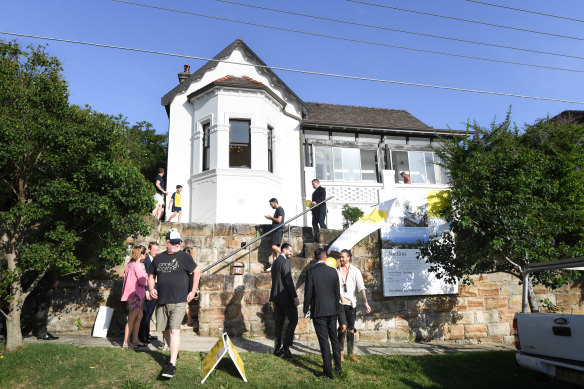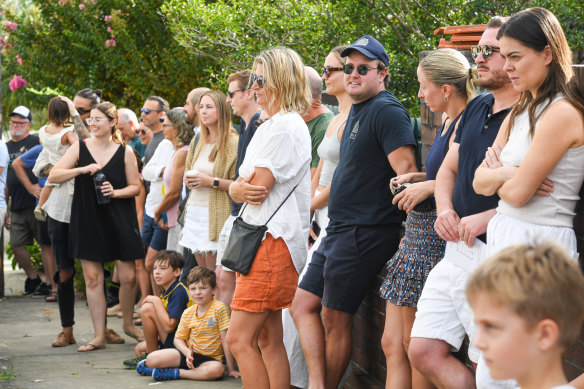Sydney property investors are facing mounting costs as their mortgage repayments climb even faster than rapidly rising rents.
But while it may push some investors to sell it could encourage others to get into the market, experts say, thanks to better prospects for claiming negative gearing tax concessions that cost the government billions of dollars in foregone tax revenue.

Increased rents do not come close to covering a mortgaged landlord’s rising repayments, new data shows.Credit: Peter Rae
Despite an ultra-tight rental market, record rent increases have not matched rising mortgage costs in any council area of Sydney, CoreLogic modelling shows, leaving new investors in a worse position by as much as thousands of dollars a month.
A Sydney investor who bought in March would spend $334 more per week on mortgage repayments for a median-priced dwelling, than they if they bought it three years ago. By comparison the median weekly rent increased $127 between March 2020 and March 2023, leaving mortgaged landlords $207 worse off.
Investors in the Ku-ring-gai council area had the biggest deterioration at $871, as mortgage repayments climbed by $1047 per week, while rents increased by $176.
It was followed by the Hunters Hill and Woollahra council areas where investors were left worse off by $692 and $577, respectively.
The modelling is based on median rent and home valuations. It assumes a 30-year loan term with a 20 per cent deposit and weekly principal and interest repayments on a mortgage rate of 5.26 per cent. It does not account for the landlords who have built up equity or own their properties outright.
CoreLogic head of Australian research Eliza Owen said interest rate rises have outpaced rental growth in all pockets of Sydney and investors will be unable to recoup increasing mortgage costs through rent increases alone.
“An investor can’t fully pass on the increase in their mortgage to rents because I don’t think renters can afford that,” Owen said.
As a result, more investors, particularly those who purchased in recent years, will be negatively geared, she said.

Experts say while it may push some investors to sell, it may encourage others to get in due to better prospects of negative gearing than years past.Credit: Peter Rae
An increase in negatively geared properties would reverse the decline previously seen when the cash rate fell to record lows, Owen said. It has also been tipped to cost the federal government billions in forgone tax revenue in years to come.
Rising mortgage rates had already deterred property investors, Owen said, as investor lending was down 45 per cent since its recent peak in March 2022. This could ultimately limit the much-needed supply of more rental properties.
But AMP Capital chief economist Dr Shane Oliver said rising mortgage costs could encourage more investor activity, as in years past, as landlords were more likely to be able to claim tax deductions.
“Rates have gone up so much more than rental yields, it’s made negative gearing a lot more attractive than what it was a year ago,” Oliver said.
‘It obviously entails billions of dollars in the cost to the budget’
Dr Shane Oliver, AMP Capital chief economist
“On the one hand investors are running their properties at a greater loss, but it also has a perverse effect as negative gearing goes up. It encourages more investors to get in,” Oliver said.
On balance, the maths in favour of negative gearing had improved for many investors, Oliver said, potentially costing the government and taxpayers billions of dollars.
“If we’re seeing a sharp increase in interest rates, therefore a sharp increase in cash flow losses on rental properties, then it obviously entails billions of dollars in the cost to the budget,” he said.
Oliver said a rise in negatively geared properties would likely be a motivation for investors, rather than a barrier, but warned it may take a while for them to return in decent numbers, as some may be holding out for a “better time” to buy.
Independent economist Saul Eslake said two-thirds of landlords were negatively geared in the 2017 property market peak. That dropped significantly when interest rates fell to record lows in 2020 and 2021.
“We will see a significant rebound in the number now,” Eslake said.
Landlords were still in a strong position though, Eslake said.
“Landlords at the moment, because the market is so tight, set the rent at what the market will bear,” he said.
While some were selling, it was not necessarily a bad thing if an investment property sold to an owner-occupier, because it would improve homeownership rates, he said.
Raine&Horne Unlimited’s Jane Schumann had yet to see an influx of investors selling, but said that, and investor activity, could change as mortgage repayments climb.
“We definitely haven’t seen a great big dumping of investment properties,” Schumann said. “There probably will be once they’re off those fixed rates. But we’re still dealing with investors at our inspections.”
Grattan Institute economic program director Brendan Coates said more investors were likely to be losing money, and eligible for negative gearing tax concessions, as mortgage rates rose.
Costings undertaken by the Parliamentary Budget Office on behalf of the Australian Greens last year predicted negative gearing would skyrocket to $97 billion over the next decade, but that analysis was based on lower interest rates in November, and did not account for increased rents.
He said costs for negative gearing tax breaks would be much higher now.
While any increase in investor selling would reduce rental supply, if properties sold to first home buyers it could also reduce the number of tenants in the market.
Most Viewed in Property
Bagikan Berita Ini














0 Response to "Where Sydney property investors are worst off as interest rates rise - Sydney Morning Herald"
Post a Comment